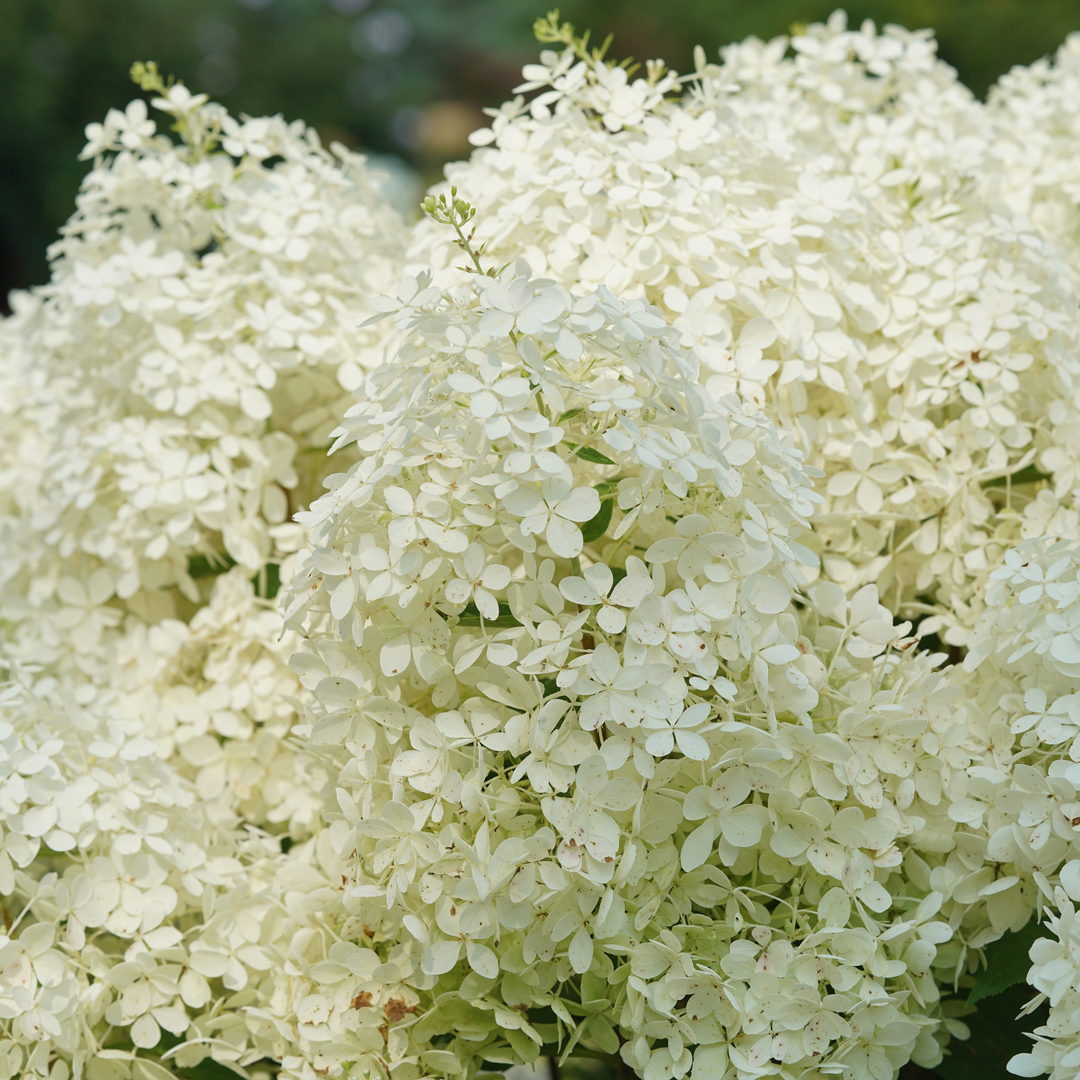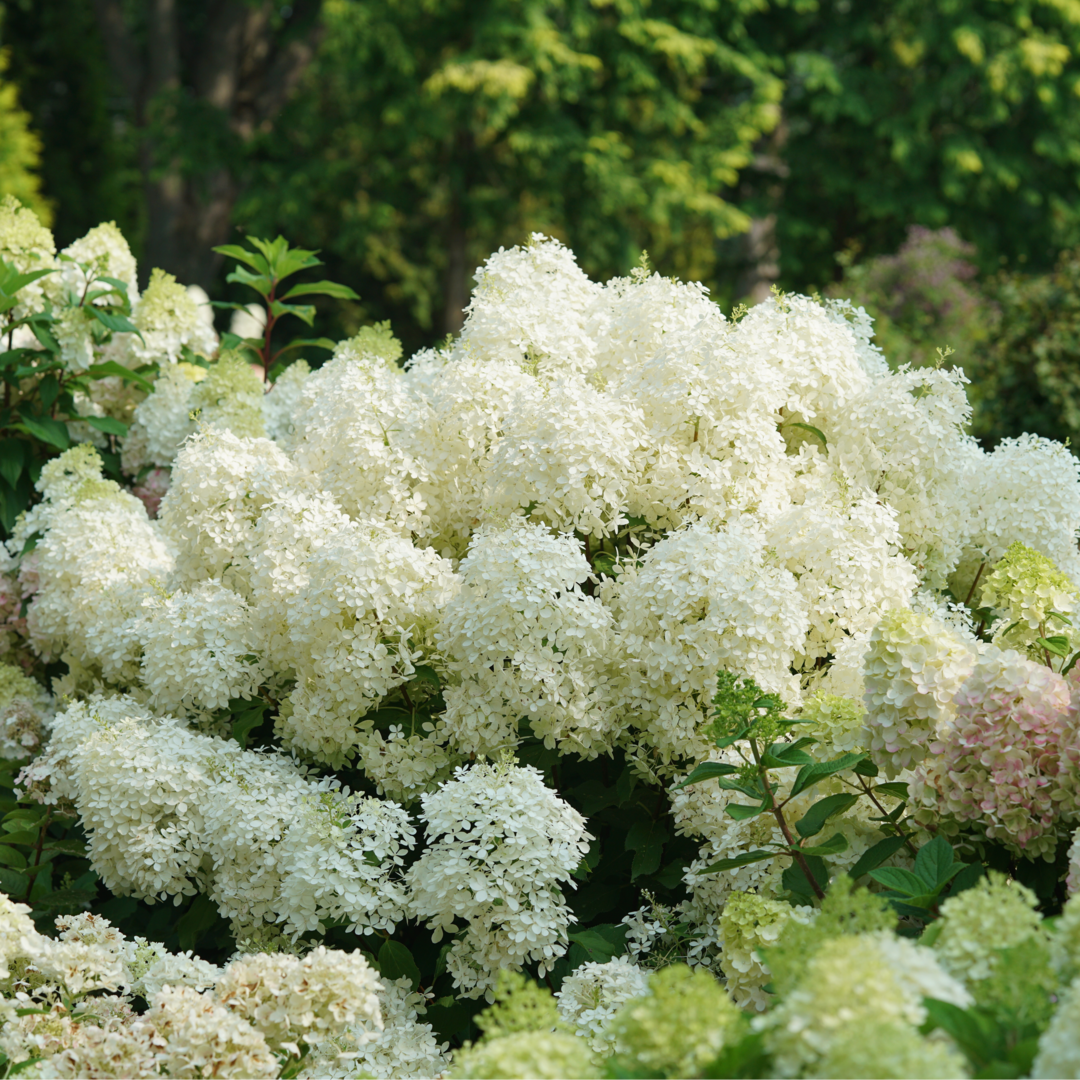
If you are completely new to gardening, panicle hydrangeas make an excellent place to start: not just because they are so easy to grow but because they are one of the most rewarding garden and landscape plants. They are very long blooming, exceptionally reliable, and adaptable to a wide range of conditions. Here's our in-depth look at how to be successful growing panicle hydrangeas.
Hardiness/climate
Panicle hydrangeas are probably the most cold and the most heat tolerant of all popular hydrangeas. They thrive and bloom reliably from chilly USDA zone 3 through balmy USDA zone 8 (even zone 9 in the case of 'Limelight'). Close to 90% of North America can grow them!
Size
There's a panicle hydrangea for every site and situation these days! Though they are traditionally quite large, reaching 8'+ at maturity, there are several dwarf varieties now that stay under 5' tall. If you need a small hydrangea, we recommend that you select a dwarf variety instead of trying to manage the height of a full sized variety. Trying to keep a large panicle hydrangea smaller through pruning will quickly become a headache, as its the volume of the root system that determines how much it will rebound after severe or frequent pruning. Starting with a smaller variety, like Fire Light Tidbit or Little Lime, will make your life easier and result in a much more attractive plant.
Light
These are the most sun, heat, and drought tolerant of all hydrangeas, and we recommend at least some sun each day for the strongest stems and the most abundant flower set. In zones 3-6, they can easily take full sun (6+ hours of bright, direct sun). In zones 7,8, and 9, they should be planted where they will be shaded during the hottest part of the day, but not deprived of sun entirely: filtered light, or a few hours of morning sun, will give you the best results. Panicle hydrangeas will survive in shady sites, but their flowering will be substantially diminished, stems may not be as strong, and flower color will be muddy instead of the rich, clear tones you see on our site.
Soil
Panicle hydrangeas are not fussy about soil, as long as it is well-drained. If there's one thing that will cause your hydrangea to fail, it's definitely wet or poorly drained soil. This is why we recommend that you do not add any kind of potting mix, topsoil, compost, etc., when you plant a panicle hydrangea. As for pH, they can grow well in acidic to slightly alkaline soils. Many people also wonder whether they can grow panicle hydrangeas in clay soils, and the answer is yes, provided that the clay is well-drained and doesn't stay wet for prolonged periods. If you have clay soil, starting with the small quart plants that we offer is an easy way to minimize digging and get a plant off to a good start.
Fertilizer
Panicle hydrangeas don't strictly need fertilizer, but will grow a bit faster if they get it. Fertilizers can also be useful in places where the pH tends more to the acidic or alkaline side, which can induce nutrient deficiencies. For most situations, applying a rose fertilizer once a year in early spring is sufficient. However, you can fertilize monthly through late July if you want your plant to grow more quickly or notice the foliage looking pale.
Flower Color
The flowers of panicle hydrangeas all start out white (or green, in the case of 'Limelight', Limelight Prime, and Little Lime). As the blooms age, most begin to take on tones of pink, red, and/or burgundy. This is a natural progression and it cannot be manipulated in any way: no matter what your soil is like, no matter which variety you grow, they will always turn pink/red. If, however, your flowers are turning brown before flower color develops, this indicates that the plant dried out during its bloom time. This can also happen in hot climates when night time temperatures are consistently high (70°F+).
Pruning
Panicle hydrangeas bloom on new wood - this is what makes them so reliable and so forgiving in terms of pruning. While pruning isn't strictly necessary, we do recommend it in most cases: it helps to create the strongest, thickest stems, as it ensures the growth for the year comes from the bigger buds lower down on the stems rather than the typically skinny buds at the tips which were created late in the previous season.
We recommend cutting the entire plant back by about one-third its total height in early spring. You can also remove any thin side branches at this time, as well as any wood that's not showing signs of life. If you prefer, you can do this in late autumn/early winter, you'll just want to wait until the plant is completely dormant before pruning. Our preference is generally to prune in spring, because this leaves the dried flower heads in place all winter, which are much nicer to look at than a bunch of cut-off branches. However, if you are concerned about snow load, or will be away from your house when spring pruning would be appropriate, the plant will not be harmed with late autumn pruning.
Panicle hydrangea problems
Overall, your panicle hydrangeas will have few issues with pests or diseases; most issues that arise are cultural (due to the way the plants are being grown). Yellowing leaves are the perfect example, as they tend to develop on plants that are getting too much water, or plants that begin to shade their inner portions as they expand in size. A small number of yellowing leaves on a panicle hydrangea is not a problem, particularly the yellowing is confined to the interior portions of the plant.
Diseases
The most likely disease to pop up on a panicle hydrangea is leaf spot. These are caused by a fungus, and though they may look a bit unsightly, they don't harm to the plant. Leaf spot fungus lives only in the leaf tissue, so once the plant drops its foliage in autumn, the leaf spot itself no longer impact the plant. However, it can come back if you don't clean up the fallen leaves (this is where the fungal spores will overwinter), and/or if conditions are favorable for leaf spot to develop, which can include plants in too much shade, and plants that get regularly pelted with water from a sprinkler system or roof overhang.
Insect pests
Insects generally leave panicle hydrangeas alone, though they can get nibbled by beetles. These typically don't impact the flowers, and a bit of insect feeding on the leaves is not problematic.
Other animals
You may find a bit of slug damage, which is recognizable for its irregular, uneven appearance, especially on younger plants or those in the shade. This isn't normally a cause for concern. Deer, however, can cause major issues for panicle hydrangeas: they especially love to eat the flower buds and may eat them before they are even noticeable to the human eye. If this happens, unfortunately, that takes away the blooming for that year. Deer damage becomes less likely the larger the plant gets, so if deer are frequently a problem in your yard, protect your plant especially in winter and early spring for its first several years. Rabbits typically leave all but young plants alone, so you may want to protect against their nibbles as well.




